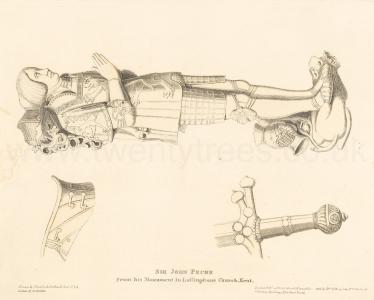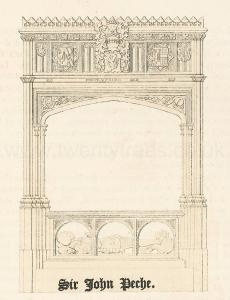Effigy of Sir John Peche
Effigy of Sir John Peche is in Monumental Effigies of Great Britain.
SIR JOHN PECHE, the most splendid amongst the gentlemen who figured in the court of Henry VIII., appears already to have advanced his fortunes in the reign of Henry VII., during Perkin Warbeck's unsuccessful rebellion. In the twelfth of that king's reign we And him amongst the foremost engaged in opposing the Cornish men in Kent, which led to their subsequent defeat on Blackheath. At the coronation of Henry VIII, Stow says, "the king ordained to wait on his person fiftie gentlemen to be speares, every of them to have an archer, a demilance, and a cistrall, and every speare to have three great horses to be attendant on his person; of the which band the earle of Essex was lieutenant, and Sir John Pechie captaine, which ordinance continued not long, the charges were so great; for there were none of them, but they and their horses were apparelled and trapped in cloth of gold, silver, and goldsmith's worke."
In 5th Henry VIII., 1513, we still find Sir John Peche employed in military achievements, accompanying the king as vice governor of the horsemen at the siege and destruction of Therouenne. In 1514 he again passed the sea from England to Calais, and was appointed Lord Deputy of that town; and the same year, in company with other nobles and gentlemen he attended to Paris the Lady Mary, sister to Henry, who was there espoused to the French King. In 1520 Sir John joined the gallant train of Henry, who exhibited at the celebrated Champ de Drap D'Or, a splendor and magnificence never exceeded in the court of any English monarcha. 14th Henry VIII, 1522, Sir John Peche terminated an existence which, as far as it appears connected with his sovereign and public life, seems to have passed in uninterrupted prosperity. The place of his death is not specified, but it is probable he was buried beneath the magnificent tomb erected to his memory at Lullingstone in Kent. Tradition there records the visits of Henry VIII. to Sir John Peche, and the Tilt-yard, the former scene of courtly splendor, is still pointed out in front of the castle gates.

Note a. At the justs and tournays held at the Champ de Drap d'Or, Hail says, Sir John Pechie, with three other knights, attended the king on horseback in his livery, which was white on the right side, and on the left side gold and russet, both hose and garment.
The tomb of Sir John Peche, situated on the North side of the chapel attached to Lullingstone Castle [Map], in a state of high preservation, ranks amongst the finest specimens of the time in which it was executed. The canopy is richly ornamented with arms and devices. In the spandrils on the South side are carved the rose and pomegranate, the badges of Henry VIII and Katherine of Arragon: in various parts of the tomb the same badges appear, both single and conjoined. In the spandrils on the North side is seen the Rebus for the name of Peche, formed by peaches and letters united, which shew that the final vowel of the name was accented—Pech-e. The same Rebus is repeated elsewhere on the monument. In the centre of the canopy on the N. and S. sides are escutcheons, bearing the modern arms of Peche— a lion rampant crowned, queue forchée, surmounted by the crest on a wreath of peach branches fruited, a lions head crowned. Beneath the escutcheon on the South side, appears the motto of Sir John Peche, Prest aa Faire, and in the same situation, on the N. side, this inscription, Peche me fieri fecit, most probably allusive to the tomb having been made during the lifetime of Sir John, by his order and direction. The motto is repeated in various places about the monument; amongst the heraldic devices is introduced the ancient coat of Peche, a fess between two chevrons.
The effigy, which lies at the lower part of the tomb, represents the knight, wearing over his armour a rich emblazoned surcoat, wrought on the border with the motto and devices of Peche. Beneath the surcoat and plate armour appears the skirts of a haubergeon, wrought of small plates. The Tasses, which nearly cover the Cuisses, are formed of The double-tailed lion crowned, is placed at the feet of the figure, and not far from it, on the right side, the gauntlets of the knight.
The arms of Sir John Peche, at the bottom of the first page are taken, from a window in the chapel at Lullingstone.
Details:—Plate 1.—Fig. 1. The Gorget:—2, 3, and 4, Motto, and Devices on the Surcoat. Plate II.—Fig. 1. Hilt of the Sword:—2. Specimen of the plates forming the Haubergeon.

